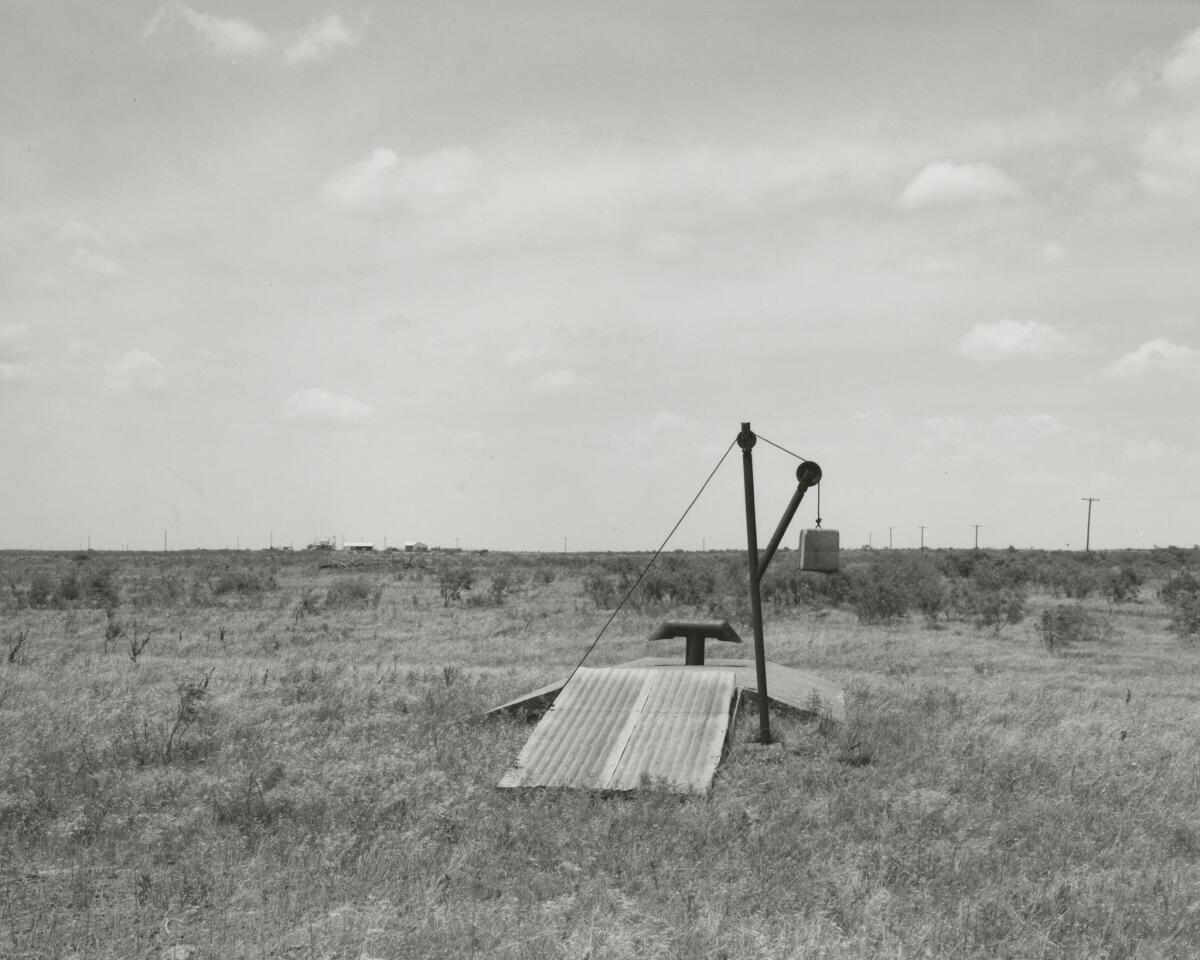Review: Frank Gohlke photographs vernacular truths in ‘Texas Memories’
- Share via
In a black-and-white 1974 photograph both ethereal and mundane, Frank Gohlke shows a man in profile lightly bundled up in warm clothes and standing in a grassy field among barren trees. A sliver of light lines the right edge of his body as diagonal shadows on the ground rake to the left. Together they peg the time of day as late afternoon.
What’s odd about the picture, one of 37 in “Texas Memories,” Gohlke’s lovely show at Gallery Luisotti, is the low, drifting cloud that partially obscures the solitary figure. It’s smoke caught in a gentle, wintry breeze.
The languorous, ghostly haze rises from an ordinary barrel in which the picture’s protagonist is merely burning trash.
Gohlke was one of 10 photographers included in the landmark 1975 exhibition “New Topographics: Photographs of a Man-Altered Landscape.” The show was instrumental in shifting the popular landscape genre away from romanticized grandeur, typified by
Most of the show is composed of vintage prints from the 1970s and after. (“My dad burning trash” and a few others are reprints made this year.) They elaborate on Gohlke’s gift for coaxing abundance out of little.
That strategy is pictured in a modest image of a tall, scraggly pear tree standing next to a dull, conventional little house; the tree is misshapen but fairly groaning with ripe, luscious fruit. This is an unassuming American Eden, the photograph a fine specimen from its tree of knowledge.
Gohlke had planted the pear tree in 1954 — he was 12 — next to the house where he grew up in the former oil-refining boom town of Wichita Falls, Texas. (That’s the birthplace of Exxon Mobil chief Rex Tillerson, tapped to be our next secretary of State.) He returns to the region regularly to photograph. Other Lone Star memories include the epic 1979 tornado that destroyed one-fifth of the small city, ranking as the worst American super-storm to date.

Five years later, Gohlke photographed an old, incongruous-seeming storm-cellar in a vacant, wide-open field about 10 miles down the road. A counter-weighted pulley-contraption rises above the underground lair to allow the heavy metal door to keep from flying open and exposing the cave. Old survivalist ingenuity seems strangely poignant — exhausted and even obsolete in the barren world outside.
Three pictures of storm cellars embedded within the flat terrain are on view. One of them is one of two color photographs in the otherwise black-and-white show. The vivid green grass and surrounding grove of lush, leafy saplings speak of an extended serenity, while a grim history is recorded in the torn-up edges of the storm-cellar door.
Much of Gohlke’s work is like that — pastoral yet never just benignly so. Human interaction with the landscape reads visually as at once inevitable and futile, inspiring and dispiriting in roughly equal measure. Look out over the postcard view of a meandering Wichita River near the aptly named town of Petrolia, and an agreeable ripple in the water is created by a tossed-out tractor tire gently interrupting nature’s eternal flow.
Gallery Luisotti, Bergamot Station, 2525 Michigan Ave., Santa Monica. Through Jan. 14; closed Sundays and Mondays. (310) 453-0043, www.galleryluisotti.com
Twitter: @KnightLAT
ALSO
LACMA's uneven new Picasso and Rivera show reveals an unprecedented, must-see discovery
Roundup: Islamic State in Palmyra, Trump security zone and big developments for the Arts District
Huge Arts District development along L.A. River races for approval; here's an early look
The biggest entertainment stories
Get our big stories about Hollywood, film, television, music, arts, culture and more right in your inbox as soon as they publish.
You may occasionally receive promotional content from the Los Angeles Times.








